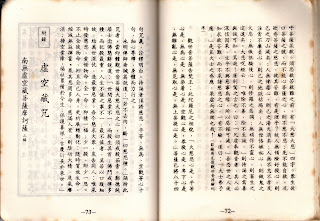The DaBei Zhou/ Great Compassion Mantra is one of the prominent texts of Chinese buddhism. Mantras do not have an open meaning, they have been described as 'mystic syllables'. They do not make sense in Chinese, Japanese, or, for that matter, Korean, but somehow are comprehensible by the Gods.
The 84 lines that comprise this mantra are understood by the Chinese as being the names and attributes of the Buddhisatva Guanyin/Avalokiteśvara. These 84 attributes are illustrated as 84 figures. However, Scholars like Lokesh Chandra consider this mantra to be a recitation of the 84 names of Harihara; as such, they (and the Wikipedia Article) prefer to call this text the Nīlakaṇṭha Dhāraṇī. Still, it is the Chinese text that is being presented here, and as such we would prefer to stick to its Chinese name-- Dabei Zhou.
Western Buddology considers this mantra a Funeral text. However, the actual uses to which the Mantra is put are much more diverse. Reciting this mantra brings untold numbers of benefits; it extends life, it brings good luck, and it averts disaster.
The Chinese text in this volume contains several miracle tales involving the mantra. Persons who recited the mantra were delivered of illnesses. When it was recited over an insane woman, she was cured instantly. When a house caught fire, a neighbour's family recited the mantra, and it went out at once. A stormy river was calmed instantly when the mantra was recited. It even saved a man's life from multiple assassination attempts.
In turn, the text describes how to create Great Compassion Water 大悲水. This is water over which 49 repititions of the Mantra have been recited. The water has miraculous properties; It heals the sick, and when splashed over houses, prevents them from being burnt down.
If you are curious as to how the Mantra sounds, here is a video of it chanted very fast: https://www.youtube.com/watch?v=kEjjzzvhhWM
***
This volume is an example of the cheap religious tracts that are regularly distributed in Singapore. It is a small volume; its dimensions are 10 by 13 cm. The present book probably dates from the 1980s. Works of a similar content and structure were still available in Singapore till about 2015.
Like traditional chinese texts, this text is read from Right to Left, (mostly) in vertical columns.
I have placed headings over the start of relevant sections, so the reader will have a rough idea of what is contained inside them. I intend to translate parts of this work, and publish them on the blog at a later date.
UPDATE; this book has been uploaded into Internet Archive, and is freely available to download from there https://archive.org/details/gsyps84xiangdabeizhou/mode/2up
Frontispieces of Buddhas etc.
Introduction: (1)
Start of the Pictorial explication of the 84 sentences of the Mantra (3)
An image of Weituo, protector of Buddhism (50) and dates set aside for abstaining from eating meat. (51)
Instructions for reciting the Mantra: (52)
The Sanskrit version o the mantra in Romanization (54), followed A phonetically annotated translation of the Chinese version. (55) No less than two transliterations are used for the Chinese version. The first is romanization, which is added throughout. The second is the use of Chinese characters that have the same pronounciation as the more obscure characters, added every whenever a particularly difficult character occurs.
The end of the Mantra, (R) and the start of a section on the virtues of the Mantra
How to create 'Great Compassion Water' (68) and miracle tales associated with the mantra (69) . For a translation of the miracle tales, see https://edwardwhite123.blogspot.com/2020/01/miracle-tales-of-great-compassion-mantra.html
Mantra of Ākāśagarbha (74) , and an essay against killing (75)
The Ten Vows of Samantabhadra (78) , and the start of the Heart Sutra (70)
The Mantra Om Mane Padme Hum (82) in Chinese and Tibetan script.
This book was sponsored by Zhou Chaosong 州潮松 and his family.




















































No comments:
Post a Comment